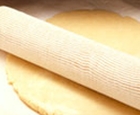|
French Dessert
Noel's Pie Crust
(For 8"- 9" pie)
From my dear friend, Elise, a true cook. She learned this recipe years ago from her dear friend, Noel, a french chef.
2/3 C lard *
2 C flour
1/2 tsp. sugar
1/2 tsp. salt
1 egg (beaten)
1 tsp. vinegar
ice water
Step 1: mix lard with flour, sugar and salt in a food processor, pulsing 6-8 times into coarse meal. In a small bowl, whisk egg with vinegar and add enough ice water to make a 1/2 C. Add this to flour mixture and pulse, just till mixture begins to form a clump. Turn out onto floured counter, knead for 5 seconds. Do not over handle dough!
Step 2: divide dough in half, wrap each piece in plastic, and chill for 1 hour.
Step 3: for double piecrust, roll both pieces out on floured surface to 1/8” thickness. Carefully fold one piece in half, place fold in center of pie plate and unfold. Add filling to pie, then top with second crust, trimming to 1/2" over hang. Crimp edges, cut large X in center for steam to escape and follow recipe. Wrap and freeze any unused dough for another time.
* Yes, lard! It's back: New York chefs are running back to lard. It has no transfat, it's no worse than butter, and it makes the ultimate flaky crust.
| See more French recipes |
|
|
Tips & Glossary
Bouquet Garni: (boo-kay gar-nee) bundle of herbs tied together with string or wrapped in cheese cloth square; usually parsley, thyme, bay leaf, and peppercorns. Flavor is released during long cooking.Remove before serving.
Chervil: (sher-vil) related to parsley but has a delicate anise flavor. Long cooking kills flavor, so add at the last minute.
Cornichon (kor-nee-shon) teeny-tiny pickle, served with pates & smoked meats; found in specialty food stores.
Fines Herbes: (feen-airb) mix of finely chopped herbs: parsley, chives, tarragon, & chervil. Not as strong as a bouqet garni. Buy it at most grocery stores.
Fromage: (fra-mahj) Cheese! The French eat more than any nationality, 45 pounds per capita per year; and the country makes more cheeses than any other country, about 400.
The three great pedigreed French cheeses are:
• Brie (East of Paris)
• Camembert (Normandy)
• Roquefort (Southwest France, from sheep’s milk)
There are also wonderful lesser-known cheeses:
• Beaufort (Rhone Alps, hard, yellow Gruyere-type)
• Chevre (Loire Valley, soft, goat’s milk)
• Comte (Alps region, hard, yellow Gruyere-type)
• Emmental (Alps region, “Swiss” cheese with holes)
• Gruyere (hard, yellow cheese—originally French, now most is Swiss)
• Tomme (means “cheese”; soft, many varieties, all from skim milk)
Herbes de Provence (airb-duh-pro-vonce): mix of dried herbs, usually thyme, rosemary, marjoram, basil, & bay leaf Can be found at most grocery stores.
Mutarde: (moo-tard), mustard. Most famous:
• Dijon ( from the town in Burgundy)
• Meaux (from Meaux, east of Paris; whole-grained; made by Pommery).
Nicoise Olive: (nee-swaz- oh-leev) small, purplish-black olive with a mellow, nutty flavor; used primarily in Salade Nicoise. The Picholine variety is a green, medium-sized olive with a light, nutty flavor.
Roux: (roo) paste-like mix of melted butter and flour, into which liquid is gradually added. The basis of every classic French sauce.
Basic Roux: 1 part butter to 1 part flour. Melt butter and add flour, stirring vigorously, till it becomes a paste-like consistency. At this point, add slowly whatever liquid your recipe calls for
|
![]()
![]()